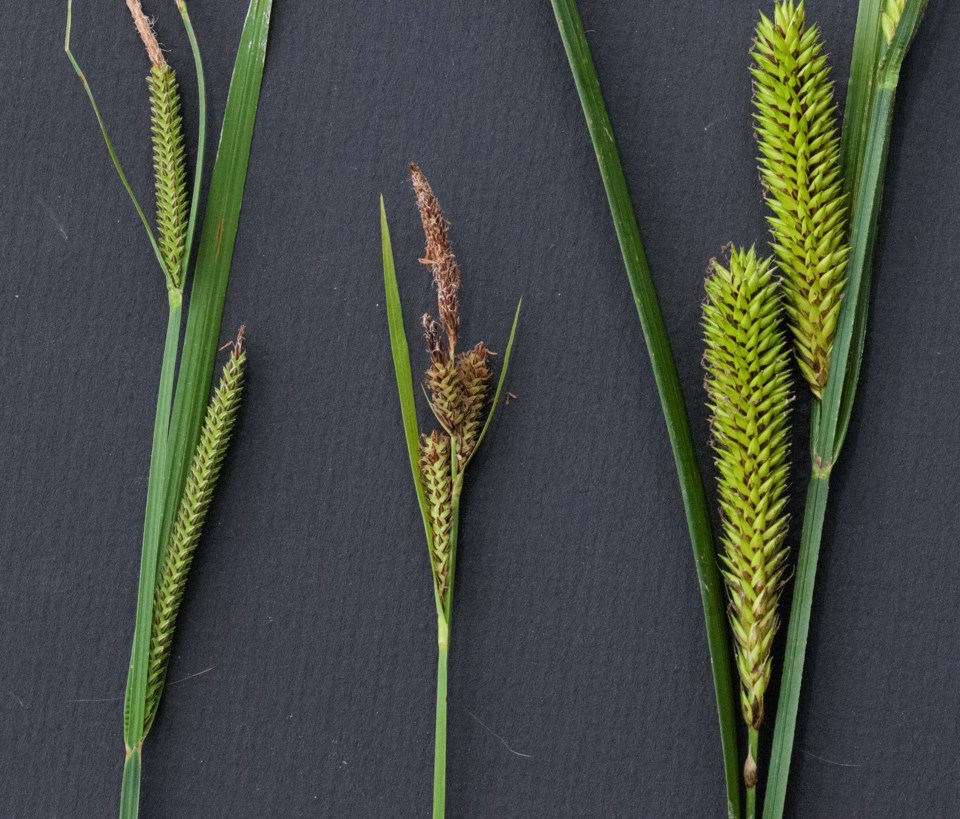This is an awkward time of year for those who profess to be a naturalist.
The spring flowers are pretty well over, the song birds have stopped most of their singing and the woods are now dark and deep in shadows. Not that any of that is a bad thing, it just that the excitement of spring has slipped away and the lazy summer days haven’t quite arrived.
If you’re feeling a bit bored, well, I’m here to help as there is a group of plants growing out there that peaks in June and July and they will definitely give you a challenge with your identification skills. I speak of sedges.
Yes, sedges. Not those look-alike grasses or rushes but rather those plants with the triangular shaped stem, the many kinds of sedges.
They can be quite exciting to discover and will definitely push your patience to the limit as you try to determine if you are looking at Carex pseudo-cyperus or its close look-alike Carex comosa. What that’s you say? A tad confused? I’m here to help.
Sedge speies don’t always have a common name, although some do, simply because there are so gosh darn many of them.
However, out of the 3,000 species worldwide there are only one hundred or so found around here (see how easy it’s getting already). This group of plants make up about six percent of all the plants growing in the great outdoors.
Those folks who find great delight in figuring out if the sedge in hand has a two-styled beak or a three-styled beak have always been in the minority (for some reason), but all that is changing.
New identification books and escalating pressures on the land have combined to create actual jobs for people who love nothing better than to peer through a dirty hand lens to look at the sex life of a plant.
Botanists are hired to determine the absence (or presence) of rare sedges as well as the more glamorous wildflowers, reptiles, trees and birds that make up that ever growing list of rare things (that used to common).
Sedging isn’t for everybody. It’s tedious. It’s demanding. It’s downright boring at times. But when a new sedge is discovered, boy-howdy but the blood can get pumping!
If you are like that, then you are a sedge-head. If you crave the thrill of a new sedge every field trip, then you are a sedgeaholic (my word, but you can use it if you like).
To figure out which species of sedge has just been tripped over, you need to check the culm, the perigynia, the spikelet and the beak... and if it really gets tough don’t be shy about taking a long, hard look at the achene of the thing.
Here’s an inside tip: sedge-heads change the name of common things to make it sound so much more mysterious and academic than it really is. Culm? That’s a stem. And that cluster of seeds is called a spikelet.
Each seed is wrapped in a sac or pod, but sedgers prefer to call that a perigynium. And if the sac has a pointy end it is referred to as the beak; some sedges have straight beaks, others have bent beaks, and some have no beaks at all. Hope that simplifies things for you.
Some of the great things about doing sedge identification is that you don’t have to get up at 5:30 a.m. to find them (like birds, for crying out loud), they grow in any habitat, and are found commonly.
So with very little effort you may find a sedge or two without really trying. And it’s legal. It just doesn’t get much better than this.
However, to become a good sedger, you will need a fairly powerful hand lens, and a mighty tome or two of reference material, sharp eyes, an excellent level of record keeping, and a cool wide-brimmed hat.
There are only a couple of handy field guides to help with field identification, but the same was said of dragonfly and damselfly guides a decade ago, and now there are numerous books to help you nail down the name of that Odonata that just buzzed by. Sedges are the next big publishing trend (at least that’s my prediction).
I recently took a quick wander through a couple parts of the Copeland Forest and made notes and took photos of the sedges encountered. Over 20 kinds were noted… and at least three were identified. The others have been photographed (150 images by the time I got home) and now begins the tedious job of labeling the images accurately.
Once upon a time my plant identification mantra was “sedges have edges and rushes are round” and I left it at that. Oh the sweet innocence of my youth.
Now I know that sedges have triangular (in cross section) culms with a wide variety of spikelets that contain (or may not contain) pistillate and staminate spikes within which an achene may be found that is either triangular in cross section or lens shaped.
Oh, and the perigynium could be fuzzy, slightly hairy, pubescent, glaucous… or not.
Next time you are out wandering and you see a guy with a wheelbarrow full of books peering through an ancient magnifying glass, don’t get too close. It might be me, and my happy dance at finding a new species can be quite exuberant.
